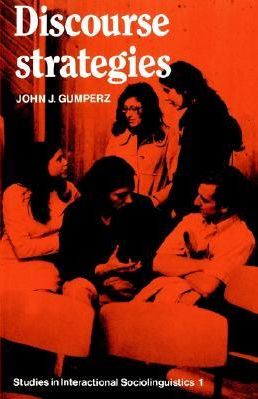Discourse Strategies
John J. Gumperz
Gumperz, John J.;
Discourse Strategies (Studies in Interactional Sociolinguistics 1)
Cambridge University Press, 1982, 225 pages
ISBN 0521288967, 9780521288965
topics: | linguistics | social | dialogue
A classic work on language in use. It is a sad loss that Gumperz passed away on March 29, 2013.
Gumperz is considered one of the founding figures in sociolinguistics, but his primary passion was in unearthing the implicit meaning behind the many choices one makes in day-to-day speech. He was particularly interested in code-mixing - where words or structres from one language mix with those from another language. In one fascinating example below, the two parts may be saying the same thing, but the meaning is seen to be changing very subtly if the "we" language comes before the "they" language, and vice versa.
These are very difficult problems, and it is amazing that Gumperz could make so much progress in a cluttered space. As Sarah Goodyear writes of him in an obituary in the Atlantic, "Gumperz never retreated from the messy world to academic abstraction. He was always interested in the real-world application of his ideas.". Indeed, in another obituary, Margalit Fox discusses how he would be occasionally called in to resolve disputes arising out of linguistic / cultural misunderstandings.
He was also a strong India lover, after spending two years doing field work on variants of Hindi and also on the Munda languages and visiting several other areas in India.
Code-Switching
A good part the book - chapters 3 and 4 and several references sprinkled
elsewhere - deal with the social and pragmatic roles of code-switching -
where one language (code) is interspersed into another, as in
"mai exams ace kar diyA."
the analysis here is illustrated with brilliant examples from
slovenian-german, spanish-english, hindi-english etc. - often dealing with
the same word (e.g. English "fix") being borrowed in multiple host
languages (say, German and Hindi - see below).
When does a usage constitute a regularized borrowing, and when is it mixed
code? Clearly, if we look at etymological roots, most words in all
languages are foreign. An alternate view may be to look for loan words
that are "recent in origin". But this is not easy. In this Hindi-English
usage:
(6) jo wo acchA ticar hota (Anyone who is a good teacher) he'll come
straight to Delhi.
Most Hindi speakers would say that the word tichar (teacher) is an English
word here. It "has a recognizably English phonological shape". However,
here it is used as a Hindi item since it obeys Hindi number and gender
concord rules.
[In the bAnglA TV serial "serA paribAr", the host (Mithun Chakrabarti) has
the families try to say a paragraph without using any English words - yet
many of these words - e.g. "lAin" as in "du-lAin-er chiThi" - have already
become quite bAnglA in their usage. By the same argument, words such as
jAnAlA (portuguese), or AynA (farsi) - indeed all Sanskrit derivatives -
may be thought of as "foreign"]
Some other seemingly marginal cases are:
(9) Er hat das gefixt (he fixed it). (G)
(10) Usne fix kiya (he fixed it). (H) [p.67]
both grammatical features and lexical roots can be borrowed. In (9) the
italicized borrowed verb stem takes on German prefixes and suffixes, while
in (10) the same English stem fix forms a compound verb with the Hindi kiya
serving as the inflected auxiliary.
Whereas borrowing is a word and clause level phenomenon, code switching is
ultimately a matter of conversational interpretation, so that the relevant
inferential processes are strongly affected by contextual and social
presuppositions. p.68
Here is an analysis of an extended Spanish-English passage,
originally cited in Labov:
Many of the seemingly English items clearly
count as borrowings... Examples are: happy in "me siento mas happy";
free in "mas free."
Proud of it in "yo no estoy proud of it" is marginal, but probably
also a borrowing because of itsposition within the Spanish phrase. 72
Subtle social-pragmatic implications in code shifts
The pragmatic meaning of code shifts can be quite complex, and is often
opaque (at least tacit) even to speakers who use them, or to other language
users.
(30) Hindi—English. Father in India calling to hisson,who was learning to
swim in a swimming pool:
Baju-me jao beta, andar mat (goto the side son, not inside). Keep
to the side.
(31) Father talking to his fiveyear old son, who is walking ahead of him
through a train compartment and wavering from side to side: Keep
straight. Sidha jao (keep straight).
The two sequences were reversed so that 30 starts with the 'we'
code, Hindi and 31 with the 'they' code, English.
[Hindi speakers were asked to listen to the statements, and] asked if the
reversal in direction of the code switch changed the meaning of the
message.
There was general agreement that the reversal normally does make a
difference. The shift to the 'we' code was seen as signifying more of a
personal appeal, paraphrasable as "won't you please," whereas the
reverse shift suggests more of a warning or mild threat.
other topics covered ranges from role of prosody to to political rhetoric.
Biography
John Gumperz (1922-2013), long time professor of English at UC Berkeley,
was an intimate observer of the subtleties of discourse. he was
particularly attentive to spoken interaction, and especially code
switching, and originated ideas such as the "home dialect" and the
"prestige dialect" - the "we" vs "them" languages. the subfield of
sociolinguistics he founded is sometimes called Interactional Linguistics.
Deborah Tannen has said of him:
Gumperz was paying attention to the details of how language is used: your
intonation, where you pause, the specific expressions that people from
one culture or another might use. [NYT]
born in Germany as Hans-Josef, he changed his name to John Joseph after the
family migrated to the US in 1939. after a bachelors in chemistry, Gumperz
felt the possibility that language may be an object of study, and did his PhD
in Germanic Linguistics. he then spent two years at the village of
khalapur (80km N of Delhi, Saharanpur dt) as part of an
anthropological project. Here he noted that those villagers who travel more,
tend to mix standard Hindi with the local khAri boli
lect (mutually intelligible with Hind). team in India.
sharpened his interest in code-switching.
 a photo from his sojourn in India [from NYT article linked below].
One wonders what river this is, and why the cart had to come here.
(Maybe the Jamuna above Delhi, but are they trying to ford it?)
a photo from his sojourn in India [from NYT article linked below].
One wonders what river this is, and why the cart had to come here.
(Maybe the Jamuna above Delhi, but are they trying to ford it?)
from Obituary by Sarah Goodyear
Atlantic magazine I was lucky enough to take a class in linguistic anthropology from Gumperz when I was an undergraduate at Berkeley, where he joined the anthropology department in 1956. I had no idea when I walked into the lecture hall that the somewhat rumpled, unassuming bald man standing at the podium was going to change the way I saw the world forever. Gumperz told us about the research he and others had done into the way people use different ways of speaking in different social situations to gain advantage. His own early research in Indian villages had explored the concept of what he called the “prestige dialect,” the speech pattern that establishes an individual’s social dominance. He told us about the work of William Labov, who had documented African American vernacular speech in Harlem and demonstrated that black English was a linguistically consistent and grammatical variation on the language. He played us selections from a BBC series called Crosstalk that he had worked on in the late 1970s, showing British employers conducting job interviews with applicants from the Indian subcontinent – video that showed how the different styles of communication used by the people facing each other in these blank rooms created confusion. The British interviewers expected the conversations to get to the point straight away, and quickly grew impatient with the discursive, roundabout answers of the Indians and Pakistanis they were questioning. Neither party really stood a chance of truly hearing or being heard. I remember sitting in that lecture hall and watching the painful misunderstandings unfold, wishing that somehow the people on the videotapes could step outside themselves and see what I was seeing – what Gumperz was showing me. I promised myself that every time I talked to someone from a culture other than my own, I would try to remember these halting and unproductive conversations. I promised myself that I would do better. I can’t say that I have always succeeded. But hardly a day goes by that I don’t think about some aspect of what I learned in Gumperz’s class. link: Obituary by Margalit Fox, New York Times. April 2013: John J. Gumperz, Linguist of Cultural Interchange, Dies at 91
Contents
Preface vii A note on conventions xi 1 Introduction 1 2 The sociolinguistics of interpersonal communication 9 3 Social network and language shift 38 4 Conversational code switching 59 5 Prosody in conversation 100 6 Contextualization conventions 130 7 Socio-cultural knowledge in conversational inference 153 8 Interethnic communication 172 9 Ethnic style in political rhetoric 187 10 Postscript 204 Bibliography 111 ---blurb To understand the role of language in public life and the social process in general, we need first a closer understanding of how linguistic knowledge and social factors interact in discourse interpretation. This volume is a major advance towards that understanding. Professor Gumperz here synthesizes fundamental research on communication from a wide variety of disciplines - linguistics, sociolinguistics, anthropology and non-verbal communication - and develops an original and broadly based theory of conversational inference which shows how verbal communication can serve either between individuals of different social and ethnic backgrounds. The urgent need to overcome such barriers to effective communication is also a central concern of the book. Examples of conversational exchanges as well as of longer encounters, recorded in the urban United States, village Austria, South Asia and Britain, and analyzed to illustrate all aspects of the analytical approach, and to show how subconscious cultural presuppositions can damagingly affect interpretation of intent and judgement of interspeaker attitude. The volume will be of central interest to anyone concerned with communication, whether from a more academic viewpoint or as a professional working, for example, in the fields of interethnic or industrial relations.
amitabha mukerjee (mukerjee [at-symbol] gmail) 2013 Apr 28
